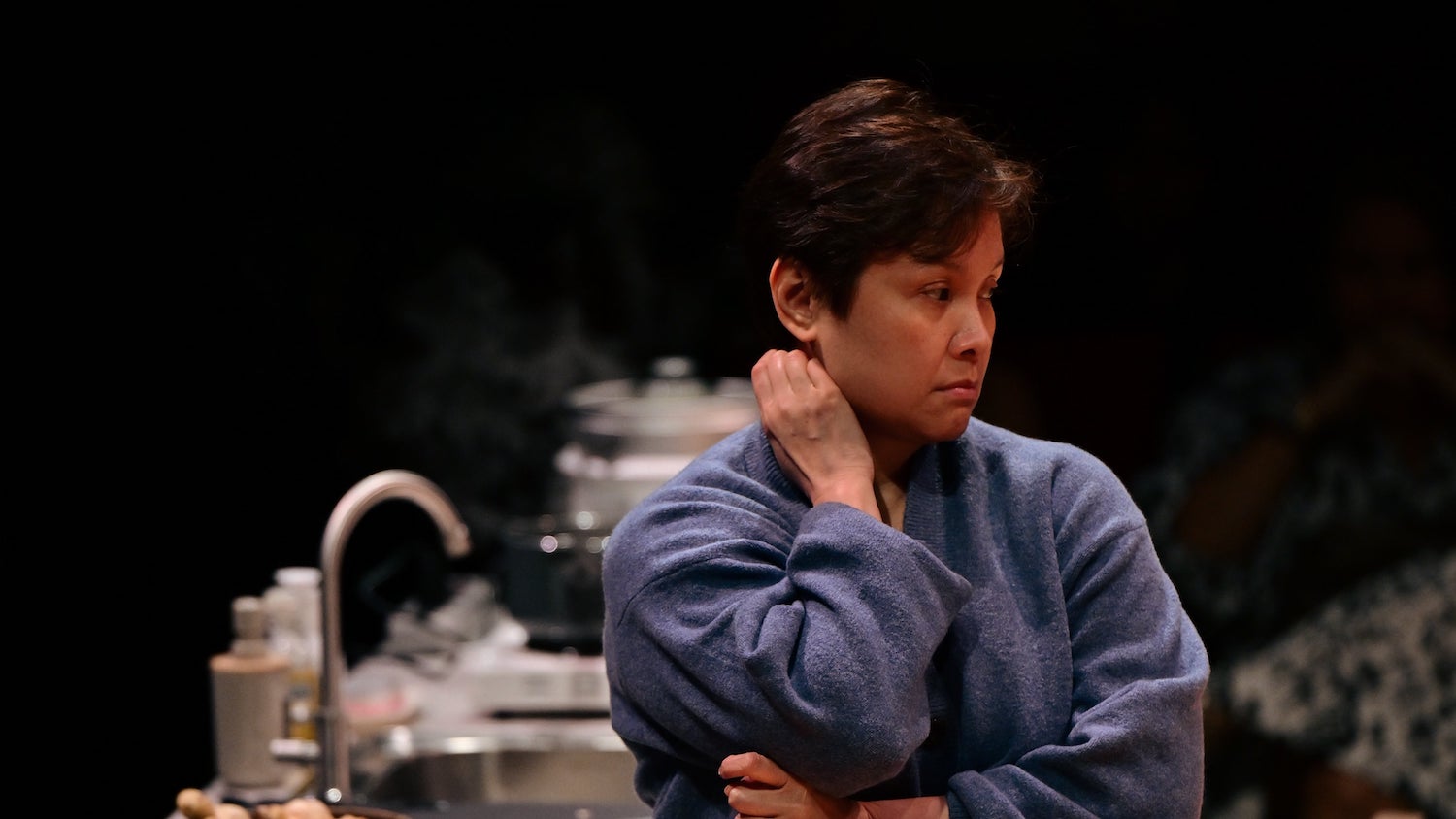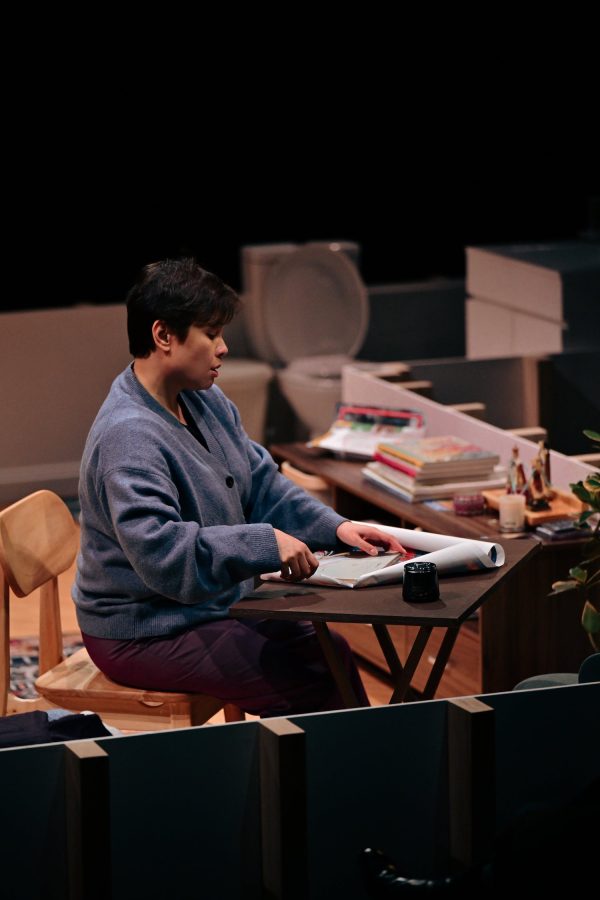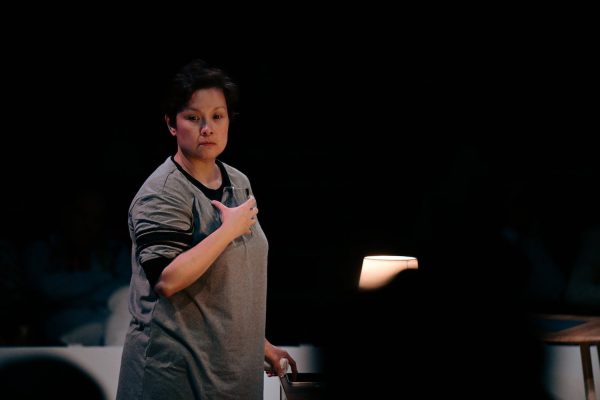
REVIEW: Finding meaning in silence and isolation in ‘Request sa Radyo’
“Lea Salonga and Dolly de Leon star in this dialogue-free one-woman show that makes for unique viewing but falls short on its insights on OFW loneliness.”
Even before one enters the Samsung Performing Arts Theater—which has been restructured to let the audience enter backstage and into a makeshift black box theater behind the façade of large shipping containers—Request sa Radyo’s ambitious concept already brings the weight of expectation to the production. With an astonishingly steep ticket price attached to it, this dialogue-free, roughly one-hour-long one-woman show starring Lea Salonga and Dolly de Leon can’t help but make one hope for a brand-new experience.
And in some ways, Request sa Radyo (based on German playwright Franz Xaver Kroetz’s 1973 work Wunschkonzert) does live up to the mystery. Watching this unnamed Filipina nurse go about her nightly routine in her lonely New York apartment arguably makes this more performance art than “traditional” theater. But even as it compels us to contemplate movement and time in a novel way, the insights that it ultimately sheds light on feel insufficient for a play dealing in extremes.
Value in the Mundane
Perhaps more so than in most productions, the set of Request sa Radyo (meticulously designed by Clint Ramos) becomes a complete extension and reflection of its protagonist, having to convey history, personality, and tension just in what elements have been included and how they’ve been arranged. It’s a simple, square apartment that contains the basic necessities: a kitchen counter, refrigerator, futon, table for two, toilet and sink, some shelving. It’s almost uncomfortable how tightly everything is packed, but the tidiness of it all provides a window into a sense of pride (or, conversely, restlessness) with which the woman keeps everything right where it belongs.

Lea Salonga; Photo Credit: Sandro Paredes/ Request sa Radyo
Ramos’s set—accompanied by Elizabeth Mak’s lighting and Brad Ward’s sound, both of which are unembellished and meant never to interrupt the show’s hyper-reality—reveals so much because director Bobby Garcia allows our gaze to wander. By his deliberately lingering on mundane actions, simple objects are infused with value and experience. But more importantly, we begin to observe ourselves in the very act of watching another person and immediately attempting to bridge the silence and distance through empathy. Even one’s fellow audience members become part of the drama; the unspoken agreement that everyone must keep absolutely quiet feels like an act of mutual respect.
At the same time, this exercise in observation naturally draws us toward the things that are absent—namely, that so much of the apartment lacks markers of her identity as a Filipino. There are no specific, branded items, and very few personal ornaments. Intentionally or not, she comes off as an individual without community.
Muted Performance
The only times we get a hint of the character’s connection to her motherland is through the titular radio program that she listens to every week, which plays Filipino songs at the request of listeners around New York. It’s also during these times when Lea Salonga (whom this writer watched for this review) is most expressive with her protagonist, whether through a satisfied smirk or a full pantomimed performance of Bamboo’s “Hallelujah.” Because for the rest of the play, she’s essentially one with the apartment—moving through it with familiarity, efficiency, but also disinterest, fatigue having glazed her eyes over.

Lea Salonga; Photo Credit: Sandro Paredes/ Request sa Radyo
But don’t misunderstand: for how muted it is, this is strong work from Salonga, who resists all temptation to fill the long stretches of inactivity with inauthentic gestures or over-emphasized responses to stimuli. There’s a complete stripping of self-consciousness necessary to playing this role, which is also helped along by Garcia’s pacing of all the action on stage. Nothing ever comes off as hurried for the sake of placating any impatient audience members. Salonga matches this measured pace with appropriate self-effacement, leading to moments of welcome, subdued humor simply because of the familiarity of how she cooks a meal (in real-time) or dries her clothes on the radiator.
More Context Needed
However, the effectiveness of Request sa Radyo hinges on the greater context that it ultimately serves. And while this version of Kroetz’s show still illustrates how a working class person’s routine can become their entire life story, it also unfortunately doesn’t do enough with its chosen context of having the protagonist be an OFW. A large part of this is because the titular radio program—the one thing that overtly ties her to being Filipino—is written in a stilted, artificial manner that lacks personality and breaks the play’s hyper-real spell. As song requests and generic side comments are read out, it becomes too obvious that this is all just invention. Much more could’ve been done to situate the program in a specific, ongoing reality, to give a clearer image of what circumstances the woman finds herself in or isolated from.
By the time the production arrives at its otherwise tense finale, the character’s actions don’t really lead to a more meaningful understanding of an OFW’s loneliness. At the very least, we’re told that it is severe, and that we must sympathize with those silently suffering—but these insights can’t help but seem like a flattened reduction of all the patient contemplation that the show invites. The culminating message that it delivers doesn’t seem to be supported by any distinct ideas that it develops itself, making Request sa Radyo more potent as an experiment in observation than as a statement on something urgent. And while this may still be interesting, for a ticket this exorbitantly priced, it should probably say much more.
Tickets: P8240 – P9785
Show Dates: Oct 10–20 2024
Venue: Samsung Performing Arts Theater, Circuit Makati, Makati City
Running Time: approximately 1 hour and 15 minutes (without intermission)
Credits: Franz Xaver Kroetz (Playwright), Bobby Garcia (Direction), Clint Ramos (Production Design), Elizabeth Mak (Lighting Design), Brad Ward (Sound Design)
Cast: Lea Salonga, Dolly de Leon
Company: Ayala Land


Comments